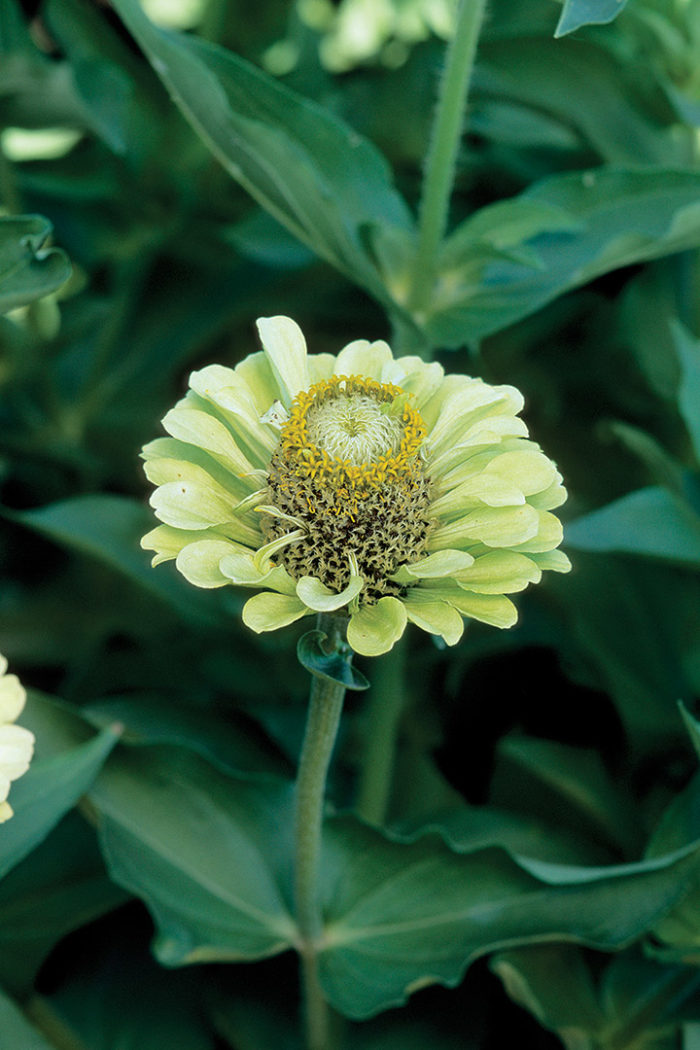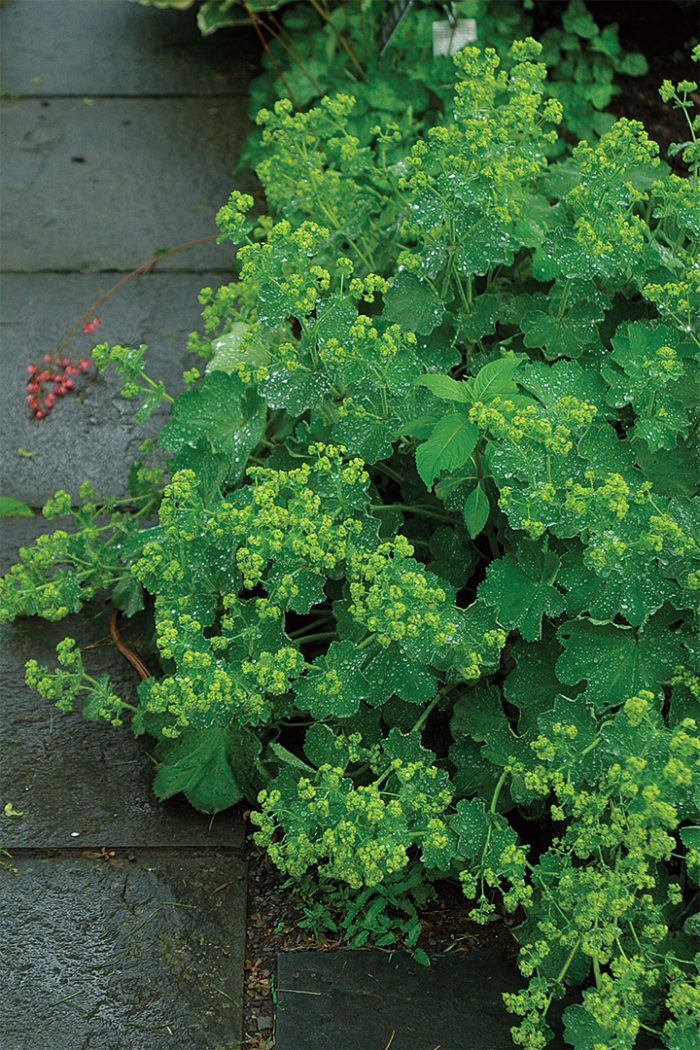
One of a gardener’s greatest goals and challenges is to plan for a season of continuous blooms: from daffodils, tulips, and lilacs in spring to peonies, irises, and clematis in summer to black-eyed Susans, sneezeweeds, and goldenrod in fall—and everything in between. It’s harder than it sounds to keep a garden blooming from beginning to end. But if you start with a well-designed tapestry of foliage, it will hold the fort during blooming gaps, and you might find that it makes you just as happy as those fickle, fleeting flowers.
Think of designing with only shades of green as the gardening world’s version of taking only black-and-white photographs. Without the benefit of an assortment of colors, a scene’s textures, shapes, and shades take control, revealing things that color might distract you from seeing. And just as a black-and-white photograph can be even more beautiful than a color print, a garden of greens can sometimes be more compelling than one liberally sprinkled with colorful blooms.

Similar leaves need differing sheens
Hardy begonia’s wing-shaped leaves may look similar to those of the epimedium, but their matte surface texture contrasts nicely to the epimedium’s shiny sheen. The fronds of the ostrich fern add some textural contrast, and all three serve to highlight the sculptural limbs of a venerable Japanese pieris, whose warm-hued bark is echoed by the begonia’s hints of red in its stems and veins.
1. Ostrich fern (Matteuccia struthiopteris, USDA Hardiness Zones 2–8)
2. White hardy begonia (Begonia grandis ssp. evansiana var. alba, Zones 6–9)
3. ‘Sulphureum’ epimedium (Epimedium × versicolor ‘Sulphureum’, Zones 5–9)
4. ‘Dorothy Wyckoff’ Japanese pieris (Pieris japonica ‘Dorothy Wyckoff’, Zones 6–8)
Designed by the staff of Chanticleer in Wayne, Pennsylvania

Varying shades and shapes are the key to making green exciting
‘Aureola’ Japanese forest grass’s flowing, chartreuse-and-green-striped leaves are a different take on green, but it’s green just the same. They make the darker greens pop, while the upright Christmas fern adds some directional contrast.
1. Christmas fern (Polystichum acrostichoides, Zones 3–8)
2. ‘Aureola’ Japanese forest grass (Hakonechloa macra ‘Aureola’, Zones 5–9)
3. Bloodroot (Sanguinaria canadensis, Zones 3–9)
Designed by the staff of the Morris Arboretum in Philadelphia

Different textures keep one shade interesting
When working with similar greens, it’s even more important to vary the textures. They couldn’t get much more different than these three plants, and all three look better for it. The hosta’s broad leaves, especially, make a wonderful backdrop for the finer textures of the holly and juniper.
1. Japanese holly (Ilex crenata* cv., Zones 5–7)
2. Hosta (Hosta cv., Zones 3–9)
3. Chinese juniper (Juniperus chinensis cv., Zones 3–9)
Designed by Mindy Arbo in Winchester, Massachusetts
*See invasive alert below.

A year-round tapestry of evergreens
This monochromatic combo, like the one above, works because, while all three plants are an almost identical shade of green, each has a distinct texture. And because the combo includes a conifer and a broad-leaved evergreen, it will please all year long.
1. Weeping Alaska cedar (Chamaecyparis nootkatensis ‘Pendula’, Zones 4–7)
2. Hardy geranium (Geranium sanguineum cv., Zones 3–8)
3. Rhododendron (Rhododendron cv., Zones 5–9)
Designed by John O’Brien in Granby, Connecticut

Subtle differences can make an impact
While the three main plants in this grouping have somewhat similarly shaped and sized leaves, they differ enough in pattern and color that they meld together beautifully. The variegated hosta, with its light green centers and darker green edges, unites the darker ‘Halcyon’ hosta and the brighter-leaved deinanthe.
1. Deinanthe (Deinanthe bifida, Zones 4–8)
2. ‘Halcyon’ hosta (Hosta ‘Halcyon’, Zones 3–9)
3. Hosta (Hosta cv., Zones 3–9)
Designed by the staff of Hollister House Garden in Washington, Connecticut

Soft, ground-hugging shade lovers are subtly pleasing
In this combo, the delicate whorls of sweet woodruff, the soft fern fronds, and the diminutive hosta have similar textures and shades, but that’s just fine. This little planting is at the base of a pergola post near a seating area, so it gets viewed up close and doesn’t need to shout. The plants don’t overpower each other, making the planting quiet and relaxing.
1. Ostrich fern (Matteuccia struthiopteris, Zones 2–8)
2. Sweet woodruff (Galium odoratum, Zones 5–8)
3. Hosta (Hosta cv., Zones 3–9)
Designed by Linda Procker in Columbus, Ohio

Add a contrasting vertical element
So many of our favorite plants form billowing mounds that monotony is a perpetual threat. The upright fertile fronds of the cinnamon fern give this green combo a dash of excitement, while its leaflets mimic the texture of the Ural false spirea in the background.
1. Ural false spirea (Sorbaria sorbifolia*, Zones 2–9)
2. ‘Sum and Substance’ hosta (Hosta ‘Sum and Substance’, Zones 3–9)
3. Hellebore (Helleborus orientalis, Zones 4–8)
4. Variegated petasites (Petasites japonicus var. giganteus ‘Variegatus’, Zones 5–9)
5. Cinnamon fern (Osmunda cinnamomea, Zones 4–8)
Designed by Barbara Weirich in Benton Harbor, Michigan
*See invasive alert below.
Ten green flowers that will satisfy any floral craving
If you’re convinced that green can be just as satisfying as a riot of color but cannot fathom a garden without flowers, why not try these plants that have green flowers? They’ll add a whole new level of subtlety and sophistication to any planting.

1. Bells of Ireland (Moluccella laevis, annual)

2. Corsican hellebore (Helleborus argutifolius, Zones 6–9)

3. ‘Envy’ zinnia (Zinnia elegans ‘Envy’, annual)

4. Flowering tobacco (Nicotiana langsdorffii, annual)

5. ‘Green Jewel’ coneflower (Echinacea purpurea ‘Green Jewel’, Zones 3–9)

6. ‘Green Wizard’ coneflower (Rudbeckia occidentalis ‘Green Wizard’, Zones 3–9)

7. Lady’s mantle (Alchemilla mollis, Zones 4–7)

8. ‘Limelight’ hydrangea (Hydrangea paniculata ‘Limelight’, Zones 3–9)

9. Mediterranean spurge (Euphorbia characias ssp. wulfenii, Zones 7–10)

10. Shiny-leaved angelica (Angelica pachycarpa, Zones 7–11)
*Invasive alert: Japanese holly (Ilex crenata)
This plant is considered invasive in NJ and TN.
Invasive alert: False spirea (Sorbaria sorbifolia)
This plant is considered invasive in ME, NH, and VT.
Please visit invasiveplantatlas.org for more information.


















Comments
Now you get online robux generator completely free of cost.
I like this act
Log in or create an account to post a comment.
Sign up Log in